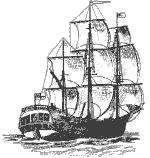Economics played a major role in pushing people away from their homes in The British Isles and elsewhere. Some early settlers were entrepeneurs, hearing about the fur trade, the timber market, and especially the fishing industry in North America. They emigrated to settle in the Canadian Maritimes or the Eastern American seaboard to make money, stopping there because the interior of the continent was primitive, inaccessible, and even dangerous.
Recent evidence seems to indicate that there was a Gillespie family in Newfoundland in the 1600's, but that research is still being investigated. There are many researchers tracking Gillespie families in the Maritimes. This history is about Upper and Lower Canada--today known as the Provinces of Ontario and Quebec.
Religious persecution, nasty landlords in both Scotland and Ireland, and finally starvation forced the expulsion of several million people in the Brtish Isles and elswhere, and created the events that led to the settlement of North America in the 1800's.
The British and French were struggling for the control of Canada in Lower Canada (Quebec) in the 1600 and 1700's. Most travel into the wilderness interior of Upper Canada and beyond was mainly by military personnel, fur traders and Indians. The British finally won the battle for Canada on the Plains of Abraham at Quebec City. Gillespies fought in that battle, and some returned to their homeland, such as Scotland. Others chose to accept the reward of free land in Canada for their service.
Meanwhile the independents in the Thirteen Colonies to the south (USA) fought to gain total freedom from Britain, and won.
Lord Simcoe in Canada in 1790 issued a proclamation inviting those Americans still loyal to the Crown to settle in Canada, with the promise of free land. The government wanted to establish a chain of military settlements in Upper Canada and increase the population of the area. . Known as United Empire Loyalists, many battle-weary, loyal British-Americans crossed into Canada at places such as Niagara to settle near Lake Erie and Lake Ontario. They also rapidly settled land along the St. Lawrence River. This history is well documented.
In 1790 the first Canadian census reveals only one Gillespie--WILLIAM GILLESPIE at Kingston, Frontenac County, Upper Canada. This was a key military outpost, about half way between Bytown (Ottawa) to the east, and York (Toronto) to the west. William died in Kingston "on Sunday last, April 1816, in his 65th year."
In 1818 a WILLIAM GILLESPY appears as a Long Point Settler in Norfok County in the southern part of the province (Ontario). His wife's family are United Empire Loyalists. He applies for 200 acres, and receives his grant of land in Walsingham Twp near Lake Erie. His family's history is documented in the book,
The Long Point Settlers.
The War of 1812 settled the major dispute between the Americans and Canada, but unfounded fear about possible other attacks prompted the Canadian Government to extend its offer of free land to populate the wilderness. A new route was devised to move troops away from the St. Lawrence River and the American border on the opposite shore. The arrival of emigrants began to increase, and access to the interior of Upper Canada was gradually improved.
THOMAS GILLESPIE, a Roman Catholic "who fought with Wellington in the Wars" arrived in 1820 to settle in Lanark County. He and his wife, Isabella Campbell, raised a large family of 10 children. The story of one of Thomas' daughters, MARGARET GILLESPIE, and her husband Hugh Johnston, and their family is documented in the history of the Township of Lanark.
In September 1818, four hundred disbanded soldiers and their families had arrived from Quebec at Bytown (Ottawa) to slash a trail 20 miles through the wilderness, south from the Ottawa River. The community they developed became known as Richmond. On December 24, 1828, PAT GILLESPI, age 28, is listed with the 1st Carleton Regiment, giving his residence as that place.. He applies for a free land grant for Richmond in 1831.
In 1823 Peter Robinson led a large group of Irish emigrants from County Cork to the Ottawa Valley, but there are no Gillespies listed with those emigrants.
In 1825 MR. & MRS T. GILLESPIE and daughter LETITIA arrive in Stormont County near Cornwall from County Tyrone, Ireland to settle in Osnabruck Twp for a few years. They would later move to Russell Township when Letitia married, and the family is buried there in a cemetery in Beaverbrook Station. There is a continued history of other Gillespies who arrive from County Tyrone in Stormont County over the following years.
The first postmaster in Fitzroy Harbour, a community further north on the Ottawa River from Bytown, near the Renfrew County border, is WILLIAM GILLESPIE. He and his wife Catherine MacDonald have several children there but the family disappears after 1838. A baptismal record for their daughter, Margaret in 1838 occurs in Perth, Lanark County, a day after the child's birth is recorded at Fitroy Harbour. This mystery has yet to be solved. What happens to William and his family is also unclear at this time.
The building of the Rideau Canal from Ottawa to Kingston between 1827 and 1832 attracted close to a thousand emigrants, mainly Irish and French Canadian. The McCabe List of Canal workers on February 1829 identifies two Gillespies, WILLIAM from County Fermanagh, Cloughy Parish, Ireland and SAMUEL from County Tyrone, Cloughy, Screeby, Ireland. Both appear to have links to Five-Mile-Town in Ireland. It is an interesting note that a William Gillespie leases property from Colonel By on back-to- back properties at #14 Church and #14 Andrew Streets on May 1, 1830. Is this the same William?
A William Gallespy purchases land in Gloucester Township, part of Carleton County, in 1832, although he doesn't live on the land until 1835. His young life ends tragically in 1841 when he is stabbed in a fight just before Christmas. It took him five days to die. He was only in his twenties. He was my paternal great-grandfather. He left a young widow Elizabeth Atkinson, and four young children. Fortunately Saml Gillespy lived nearby, and he and Elizabeth appear together on the 1851 census with her children. Most of the William and Elizabeth's family stayed in the Ottawa Valley.
Source: Gillespie Foundation Library & Databases
Records Found

EARLY TRAVEL
Port of entry to Canada in the 1800's was up the St Lawrence River to Quebec City. Yes, ships still landed in the Canadian Maritimes, but major settlement to that area was already done. Emigrants were eager for free land in the interior of Upper Canada.
By the mid 1840's, all ships had to stop at Grosse Island in the middle of the St. Lawrence River for a health inspection. Anyone sick was taken to the island, where many died from diseases such as cholera and diptheria. This was the peak of the Irish immigration, and often a ship could carry up to to 400 passengers. Records indicate that at one point 50 ships where anchored off Grosse Island on one day, waiting to be inspected before they could unload passengers.
After landing at Quebec City, emigrants were taken in large parties by smaller boats to Montreal. Arrangements were then made for travel by barge to Prescott, a rough, harduous trip of about a week, struggling up the St. Lawrence River, often walking along the shore past many rapids, and sleeping in the open.
From Prescott, people either travelled by foot or horseback north to Bytown through the woods, or continued the struggle further west until they reached a port on Lake Ontario. Steam boats were operating along the shores of Lake Ontario by 1838, with stops at Kingston, Port Hope, Cobourg, York (Toronto), and Hamilton. However, there was no continuous road from Montreal to Kingston for many years.
Sometime later emigrants were able to travel from Montreal directly up the Ottawa River to Bytown, and by barge south/west down the Rideau Canal to stops along the route, then to Kingston, and points west via boats..


A Scottish family from Lanarkshire, Scotland sent several sons of their 14 children to Canada as merchants, and this family line is being researched by several people. In particular GEORGE GILLESPIE (1772-1842) came to Canada about 1790, and seems to have been for a time in the service of the North West Company. In 1798 he was in charge of the house of this company at Fort St. Joseph's, (Ontario) and then in 1799 he was elected a member of the Beaver Club of Montreal. He became partner with his brother, JOHN, in the firm of Paker, Gerrard, Ogilvy and Co.
John was put in charge of the London office of the company, while George was sent to Michilimackinac. That year George was among partners who refused to follow Ogilvy, and chose to form another company to compete with the North West Company. Gillespie moved back to Montreal probably in 1803. He joined the Scotch Presbyterian Church, whom he supported generously.
In late 1806, George was involved in negotiations in the division of trading territory. He travelled to Washington, DC to negotiate a settlement when company goods were seized at American customs near Youngstown, New York.
In 1810 George and his younger brother, ROBERT GILLESPIE established a partnership with George Moffat. After several name changes, the company became known as Gillespie, Moffat & Company in 1816. George's son ALEXANDER GILLESPIE also worked in this office. George returned to Scotland shortly after 1812, and spent the remainder of his life at Biggar Park, Lanarkshire.
George's younger brother, ROBERT GILLESPIE (1785-1863) was also a merchant and came to Canada about the year 1800. He ultimately also became a partner in the firm of Gillespie, Moffatt, and Co. He married Anna Agnes, daughter of Dr. Robert Kerr, formerly surgeon of Sr. John Johson's 'Royal Greens'. They lived in Montreal, and they had at least one son, SIR ROBERT GILLESPIE (1818-1901) Robert Sr. later also married Caroline Matilda Arnoldi of Montreal.
Source: Documents Relating to The North West Company, Toronto, The Chaplain Society, 1934.
A Dictionary of Candian Biography Vol VII